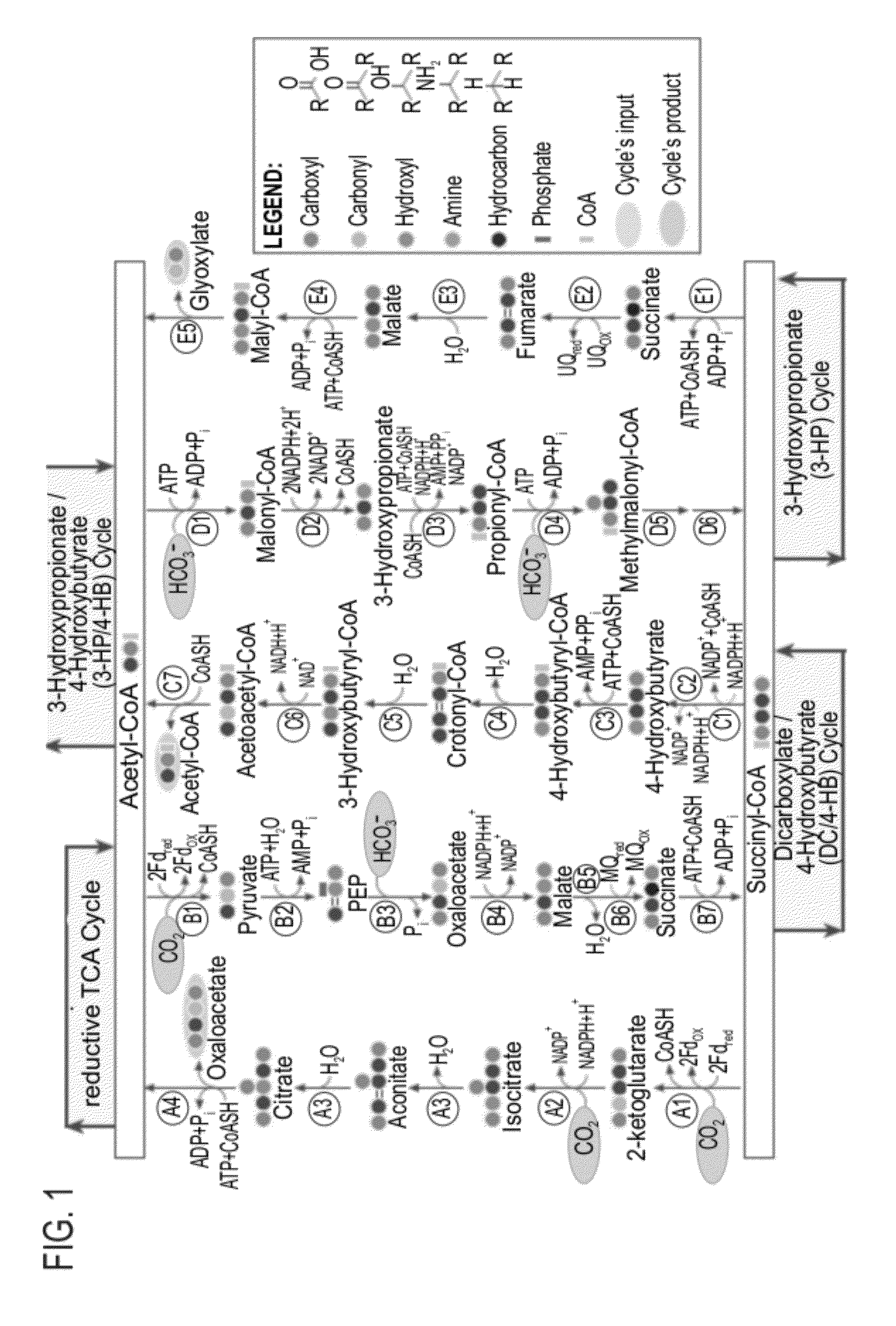Enzymatic systems for carbon fixation and methods of generating same
a carbon fixation and carbon technology, applied in the field of enzymatic systems for carbon fixation and methods of generating same, can solve the problems of limiting the carbon fixation rate, consuming over 70% of the fresh water utilized by humanity and the majority, and further optimizing rubisco may prove difficul
- Summary
- Abstract
- Description
- Claims
- Application Information
AI Technical Summary
Benefits of technology
Problems solved by technology
Method used
Image
Examples
example 1
Pathway Analysis Metrics Enable a Comprehensive Comparison Between Pathways
[0265]Many different aspects of a given metabolic pathway are important for its function. To enable evaluation and comparison of metabolic pathways, the present inventors have used several parallel criteria.
[0266]The pathway specific activity (criterion I) is analogous to an enzyme's specific activity and is defined to be the maximal rate of product formation by 1 mg of pathway total protein (see Example 2 for the exact calculation). The pathway specific activities for all natural carbon fixation pathways have been calculated and are presented in FIG. 12, Table 1 (marked in blue).
[0267]These pathways, as well as the other that were analyzed in Example 2 (including the natural pathways) are annotated and grouped according to their main metabolic characteristics, i.e., the carboxylating enzymes that create their “metabolic core”. Aside from those enzymes, a pathway is generally annotated according to an indicat...
example 2
[0303]In the present example a comprehensive view of the synthetic carbon pathways discovered using the described search is provided.
[0304]General Aspects of the Synthetic Carbon Fixation Pathways
[0305]To enable pathway evaluation and comparison in terms of the different criteria, a common pathway product was defined. Glyceraldehyde-3-phosphate (GA3P) was selected as such a metabolite because it is regarded as the product of the reductive pentose phosphate (rPP) cycle (FIG. 5A) and because it is the simplest sugar leading to the bio-synthesis of larger transport metabolites. Each pathway is therefore composed of a cycle and an assimilation sub-pathway which converts the cycle's product into GA3P (FIG. 6). The choice of which compound will serve as the pathway output does not affect the qualitative results discussed here. It may offset the energetic cost or the pathway specific activity but to similar amounts in all pathways. It is thus a useful approach but one that can be changed t...
example 3
Practical Implementation
[0425]In Vitro Implementation
[0426]The capture of inorganic carbon from the atmosphere by industrial means has received significant attention in recent years. Apart from completely chemical approaches, the in vitro reconstitution of the Calvin-Benson Cycle was proposed and pursued as an efficient alternative to perform this goal, while providing voluble bioorganic compounds. The proposed synthetic carbon fixation pathways can achieve the same goal with less enzymatic biomass. Tables 18 and 19 present the enzymatic constituents of such an in vitro carbon fixation system, operating the C4-Glyoxylate / Alanine or C4-Glyoxylate / Lactate pathway, where for each enzyme prokaryotic and eukaryotic alternatives are given, if possible.
[0427]To support carbon the enzymatic system should be provided with energized cofactors, namely ATP and NADH and / or NADPH. These cofactors can be regenerated in vitro in various ways. Notably, if one would like to provide reducing power usi...
PUM
| Property | Measurement | Unit |
|---|---|---|
| Substance count | aaaaa | aaaaa |
| Fraction | aaaaa | aaaaa |
| Fraction | aaaaa | aaaaa |
Abstract
Description
Claims
Application Information
 Login to View More
Login to View More - R&D
- Intellectual Property
- Life Sciences
- Materials
- Tech Scout
- Unparalleled Data Quality
- Higher Quality Content
- 60% Fewer Hallucinations
Browse by: Latest US Patents, China's latest patents, Technical Efficacy Thesaurus, Application Domain, Technology Topic, Popular Technical Reports.
© 2025 PatSnap. All rights reserved.Legal|Privacy policy|Modern Slavery Act Transparency Statement|Sitemap|About US| Contact US: help@patsnap.com



